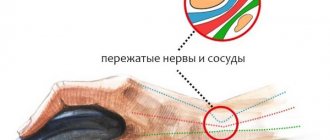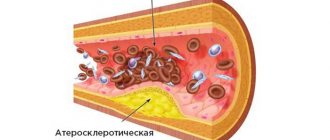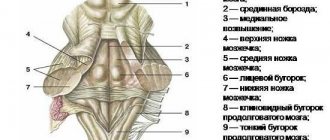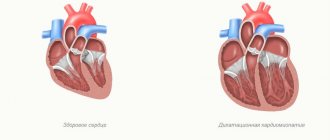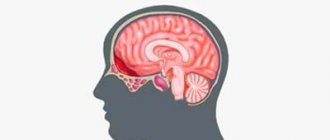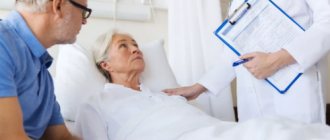Why does tachycardia appear with VSD?
With vegetative-vascular dystonia, the pulse often increases. For the development of the pathology in question, certain conditions are necessary. This usually happens when:
- chronic fatigue;
- working at night, insufficient sleep;
- nervous overstrain, neuroses;
- depression;
- smoking, poor diet and alcohol abuse;
- general exhaustion of the body;
- hormonal imbalance.
Scientists believe that most pathologies of the heart and blood vessels arise under the influence of psycho-emotional factors.
Increased heart rate is a concern with low levels of physical activity. Under such conditions, thinning of the myocardium occurs. The development of tachycardia is observed when the sympathetic department of the autonomic nervous system predominates over the parasympathetic.
This failure does not allow the ventricles to fill with blood in a timely manner, and organs and tissues do not receive it in sufficient quantities. Therefore, the heart begins to contract more often to make up for the blood deficiency.
What is the danger of the condition
If you do not deal with tachycardia during VSD, the consequences can be quite serious. An increased heart rate negatively affects a person’s quality of life, causing shortness of breath and dizziness. Lack of treatment will lead to hypertrophic changes in the myocardium. Over time, the heart wears out, its contractility decreases, and heart failure occurs.
Tachycardia accompanying vegetative-vascular dystonia is dangerous due to the development of:
- insufficient blood supply to the brain;
- cardiac asthma or pulmonary edema, which is associated with left ventricular failure;
- arrhythmic shock.
That's why it's so important to fix the problem in a timely manner.
How to solve the problem
There is no single advice on how to get rid of tachycardia during VSD.
Therefore, treatment usually comes down to:
an attempt to eliminate the factors provoking paroxysm. But there are actually quite a lot of them, and they are individual for each patient. Some patients react more to sudden changes in weather, that is, they suffer from weather dependence, others are susceptible to increased frequency of attacks due to overwork, poor diet, etc.;
- taking symptomatic medications. This refers to drugs that eliminate a specific manifestation of VSD. For example, if it is nausea, then Metoclopramide is prescribed. We will talk about medications that slow down the pulse a little later;
- rational psychotherapy. Do not be surprised and do not leave the doctor who suggested that after a series of examinations you visit a psychologist or psychotherapist. The observed pathology always has an emotional background.
Classification of pathology
VSD can manifest itself not only as tachycardia. Pulse disturbances in this condition occur in the form of:
- Supraventricular tachycardia. At the same time, the heart contracts at a speed of more than two hundred beats per minute. The attacks occur suddenly and last from a few seconds to 2-3 days. The pathology differs in its supraventricular origin. The ectopic focus can also be located in the atria or atrioventricular node. This phenomenon does not pose a health hazard, but is accompanied by nervous tension, which causes significant discomfort to the person.
- Persistent tachycardia. The pulse does not exceed 120 beats per minute. The patient may not notice the problem for a long time, since it is characterized by slow development and gradual completion. In this case, disturbances in heart rhythm and increased pressure in the arteries are observed;
- Sinus tachycardia. The generation of the impulse occurs in the sinus node. The number of heart contractions is no more than 135 per minute. Most often it affects people at a young age. If the patient tolerates the attacks well, then this situation can be regarded as a normal condition.
RECOMMEND: Possible causes of nocturnal tachycardia
Depending on where the pathological focus is located, generating incorrect impulses, tachycardia can be:
- ventricular or atrial;
- sinus.
Classification based on the cause of the deviation identifies pathologies:
- Extracardiac, when a rhythm disturbance occurred under the influence of external factors.
- Intracardiac. Heart rate increases as a result of organic damage to the heart and blood vessels.
Therapy is prescribed depending on the type of pathology.
Causes
There can be many reasons for a rapid heartbeat
It is important to be able to distinguish pathological tachycardia from the normal physiological reaction of the body to physical activity, as a result of anxiety, fear, anxiety. Heart rate may be higher or lower than normal
If a person’s heart rate is higher than normal, then he is diagnosed with pathology
The heart rate may be higher or lower than normal. If a person’s heart rate is higher than normal, then he is diagnosed with pathology.
The disease of the contractile function of the heart will be discussed in the article. During the course, the reader will learn about what causes of tachycardia are identified and how the disease is related to blood pressure, as well as the treatment of the disease.
The portal provides free consultation 24 hours a day.
Types of tachycardia
The following types of tachycardia are distinguished:
The symptoms of each type of disease will be described below. The treatment of each type of disease will be discussed further.
In addition, there are tachycardia accompanied by high blood pressure, tachycardia accompanied by low blood pressure and tachycardia accompanied by normal blood pressure.
Symptoms of tachycardia
Rapid heartbeat, the causes of which will be listed below, has a number of symptoms. Symptoms do not differ between different types of pathology.
The human heart is a vital organ whose health must be closely monitored. It is susceptible to various diseases that can occur due to one reason or another.
Against the background of more intense work of the heart during tachycardia, in some cases there is also an obvious arrhythmia, when the duration of the intervals between pulse beats is constantly changing.
In our article we will analyze the varieties of this disease, consider the symptoms and causes of tachycardia in women and men, and also touch on the topic of diagnosis and treatment of the problem.
Description of the disease
We can talk about the diagnosis of tachycardia if the pulse exceeds 80 beats per minute. The causes of tachycardia in young girls and boys can be both physiological and pathological.
Until the age of 16, a person’s heart is constantly growing and during this period its volume increases by more than 10 times. The peak development of the heart muscle occurs in the first year of life and in the puberty period - 13-16 years.
The causes of tachycardia in young men can be different, depending on the structure of the body, the level of physical activity and the structural features of the heart.
This condition can cause irregularities in the heart rhythm. Also, the cause may be an underdeveloped, too small heart. This pathology can occur with an asthenic type of constitution and a small teenager.
Literally translated from Greek, the word “tachycardia” means: - fast and - heart. Thus, tachycardia is a symptom that refers to an increase in heart rate (over 90-100 beats per minute). In most cases, palpitations cause very unpleasant sensations in people.
Causes of physiological tachycardia (rapid heartbeat)
An increase in heart rate may be a manifestation of a physiological normal reaction in response to physical and emotional stress, with an increase in ambient temperature, with an insufficient amount of oxygen in the air, such tachycardia is called sinus.
The cause of the development of sinus tachycardia is increased automatism of the sinus-atrial node and dysregulation of the sinus node with a predominance of the influence of the sympathetic nervous system.
Early recognition of tachycardia symptoms and their treatment is an important step towards the health and well-being of a patient suffering from a too-fast heart rate.
Therefore, it is so important to know the first signs of this disease and how to stop it.
Concept of tachycardia
It is a well-known fact: tachycardia is not a separate disease; it is a sign that a person has some kind of pathology (heart, endocrine system, etc.). Provoking factors trigger mechanisms that lead to an increase in heart rate.
However, it happens that tachycardia occurs in a completely healthy person, and this is considered the norm. As a result, doctors distinguish two large groups that explain the acceleration of the heart rate: physiological (normal) and pathological (caused by a specific disease).
Methods for diagnosing the disease
A frequent pulse with VSD can be detected at home. It is necessary to count the number of contractions while in a calm state. If nothing worries you, then the diagnosis is made by chance during a routine examination. To normalize the condition, it is necessary to identify what caused the violation and eliminate the cause. In this case, the following diagnostic methods are used:
- electrocardiogram;
- echocardiography;
- magnetic resonance imaging.
A conversation is held with the patient, during which the doctor collects anamnesis and identifies factors contributing to the development of hypertension. If there are organic or psychological causes, they are treated. The International Classification of Diseases identifies VSD as one of the types of neurosis. Therefore, the patient must undergo a course of restoration and strengthening of the nervous system.
Treatment of tachycardia with VSD
To eliminate the problem, a complex of therapeutic measures is used, including medication, psychotherapy, physiotherapy, correct lifestyle and other measures.
To maintain the heart in a normal state, the patient is first recommended to adjust his diet. This will not only strengthen the heart muscle, but also prevent the development of many pathologies.
It is useful to consume honey. It helps dilate blood vessels and improve heart rate. It is recommended to eat a spoonful three times a day. You can add it to cottage cheese, fruit salad, warm tea.
Rapid heartbeat with VSD is normalized with rosehip decoction.
Dry fruits in the amount of a tablespoon are poured with boiled water and kept on fire for ten minutes. After this, filter, cool and add honey. Drink half a glass in the morning, lunch and evening. If you are prone to heart palpitations, it is advisable to eat a lot of apricots. They are useful in dried and fresh form, as they contain a lot of potassium and iron. You can also get these substances from bananas, pineapples, cabbage, dates, and prunes.
To enrich the body with magnesium, you need to eat more tomatoes, nuts, celery, and grapefruits.
Potassium ensures the normal performance of the heart's natural functions. There is a lot of it in millet porridge. Your diet should include nuts, cheese and raisins every day.
In case of VSD, to prevent any unpleasant manifestations, you should give up alcoholic beverages, drugs and smoking.
RECOMMEND: Normal heart rate by age and gender
Vegetative-vascular dystonia is considered a complex disorder in the functioning of the body. It is often accompanied by increased heart rate. This is not a life-threatening condition, but some particularly severe attacks can lead to a significant deterioration in a person’s well-being. In this situation, to normalize the functioning of the organ, you need to turn to traditional methods of treatment.
After diagnostic examinations and evaluation of their results, the doctor prescribes a suitable course. Drug treatment is usually preferred. It is also recommended to pay attention to health procedures in sanatorium-resort institutions. The use of baths and massage, proper nutrition and adherence to the principles of a healthy lifestyle will help maintain normal health.
An important stage in treatment is the use of psychotherapeutic techniques. In some cases, hypnosis sessions are recommended to determine the presence of mental disorders and eliminate them.
Drug therapy consists of the use of vegetotropic, psychotropic, vascular and nootropic drugs.
To eliminate attacks of rapid heartbeat, sedatives based on medicinal plants are used. It is recommended to use tinctures of hawthorn, valerian, and peony. Of the psychotropics, Frenolone and Sonapax are used. Improved blood circulation can be achieved with Cinnarizine or Viprocetin.
For tachycardia caused by dysfunction of the heart and blood vessels, antiarrhythmic drugs are used to complement the main treatment. If a severe attack occurs, lidocaine solution is administered intravenously. In addition to it, Novocainamide, Diltiazem, Verapamil can also be used.
To completely restore the heart rhythm, drugs containing potassium are used.
If you are worried about tachycardia during sleep during VSD, during stress and mental disorders, to stabilize your health, it is recommended to take a few drops of Valocordin, Corvalol or Validol. These drugs have a calming effect on the nervous system and reduce the heart rate.
To increase the effectiveness of basic treatment, the patient is advised to take regular walks in the fresh air, nutritious food and exercise.
How to treat?
Vegetative-vascular dystonia refers to complex changes in the body. Rapid heartbeat is one of these disorders, but with VSD it does not pose a health hazard and does not lead to death. At the same time, there are moments when attacks of tachycardia are pronounced and can worsen a person’s well-being. In this case, treatment is necessary to normalize the functioning of the organ.
To diagnose VSD, laboratory tests of blood and urine will be required. By deciphering these tests, you can obtain important information about the disease. The patient is also referred for examination of those organs that are bothering him.
If attacks of heart and vascular diseases are severe, electrocardiography and echocardiography are done. Conduct diagnostics of the abdominal cavity and thyroid gland.
Often, tachycardia is treated with medication along with procedures in sanatoriums and resort institutions; acupuncture is also prescribed
It is very important to lead an active and healthy lifestyle, attend water and massage treatments that will help improve your condition temporarily.
Treatment of the disease should begin with eliminating the cause that led to the disorder of the autonomic nervous system.
An important reason in curing the disease is psychotherapy. It happens that hypnotic sessions are prescribed, thanks to which a specialist determines mental disorders of the disease
VSD is treated with medications using a number of medications.
- Vegetotropic.
- Psychotropic.
- Vascular.
- Nootropic.
To get rid of tachycardia, natural sedatives (tinctures from plants) are prescribed.
Psychotropic drugs include:
To improve blood circulation take:
If tachycardia is caused by disorders in the cardiac and vascular system, it is treated with antiarrhythmic drugs, which are necessary as an addition to treatment. During attacks of tachycardia, lidocaine solution is used for intravenous use. It can also be such means as:
To restore the pulse rhythm, potassium and drugs containing potassium are used.
During times of stress and mental disorders will help:
With the help of these drugs you can calm the nervous system and reduce the heart rate.
In order to no longer show signs of VSD, you need to do light physical exercise, walk more and eat nutritiously.
Prevention
Dysfunctions of the autonomic nervous system contribute to the development of tachycardia. Therefore, the best option to avoid such problems is prevention.
People over 45 years of age should pay more attention to their health. It is at this age that the cardiovascular system suffers under the influence of stress, chronic diseases and other factors.
Therefore, in order to avoid serious complications, it is necessary to give preference to a healthy lifestyle, eating foods that are good for the heart muscle, and a sufficient level of physical activity.
An increase in heart rate negatively affects a person’s quality of life and worsens his well-being. Therefore, it is important to eliminate any bad habits, introduce dried fruits and nuts into your diet, and spend more time walking.
Positive emotions and the absence of nervous tension are of great importance in dystonia. This will help prevent attacks of tachycardia.
If your health suddenly deteriorates, you must inform your doctor.
